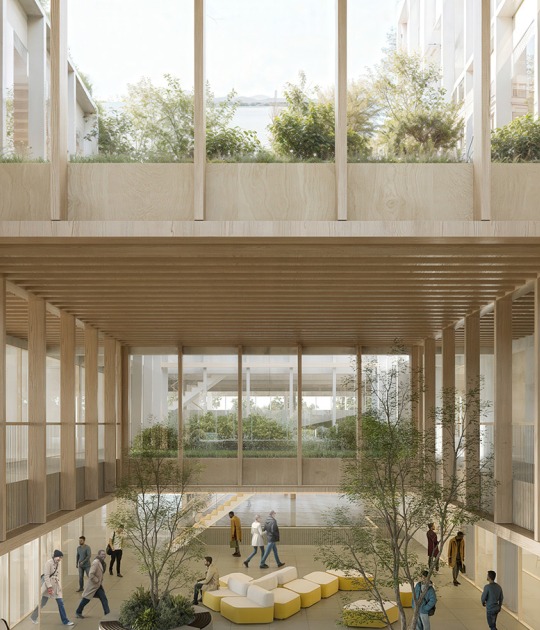Rafael Guastavino (Valencia, Spain, 1842 – Asheville, North Carolina, USA, 1908) was a Spanish architect and builder. Based on the Catalan vault he created the Guastavino tile, a "Tile Arch System" patented in the United States in 1885 used for constructing robust, self-supporting arches and architectural vaults using interlocking terracotta tiles and layers of mortar. Guastavino tile is found in some of New York's most prominent Beaux-Arts landmarks and in major buildings across the United States. It is used in a huge number of architecturally important and famous buildings with vaulted spaces. Guastavino was not the principal architect for most of the projects.
In 1881 he came to New York City from Barcelona, with his youngest son, nine-year-old Rafael III. In Spain he had been an accomplished architect trained in Barcelona and was a contemporary of Antoni Gaudi. In the March 7, 1885 article entitled The Dakota Apartment House, printed in The Real Estate Record and Builders Guide, he was listed as being the contractor in charge of "fireproof construction" of the luxury apartment building that was completed in 1884. Though not specified, the work may very well have included the groined vault entry on the south side on West 72nd Street, the north side on West 73rd Street, as well as the construction of the subterranean basement, and the 3-foot thick arched floors between the basement and attic levels. Years later he was commissioned by the firm of McKim, Mead, and White's Boston Public Library (1889), which increased his reputation with every major architect on the East Coast. His published drawings of interior decoration of the Spanish Renaissance style caught the eye of an architect, who asked him to submit a design for the planned New York Progress Club building.
After forming a partnership with William Blodgett, he eventually was offered a construction position in 1890 with George W. Vanderbilt to construct arches for the new mansion, Biltmore at Asheville, North Carolina. After working on the estate, he decided to build his own retirement home in the mountains of Black Mountain, North Carolina in a 500-acre valley. His house, Rhododendron, had a vineyard, dairy, brick kiln, and more. This property currently is owned by Christmount Assembly, the conference center for the Christian Church (Disciples of Christ). On the property there still are artifacts that may be visited, including the kiln and chimney, a wine cellar, beautiful old stone walls, and many smaller artifacts that have been rediscovered as modern buildings have been constructed.
He and his son developed twenty-four items that were awarded patents. Their company, Guastavino Fireproof Construction Company, run by the father then by his son, was incorporated in 1889 and executed its final contract in 1962.
Akoustolith was one of several trade names used by Guastavino.
Literally hundreds of major building projects incorporate the distinctive Tile Arch System. In Chicago, the central nave vaulting of Rockefeller Chapel at the University of Chicago uses 100,000 Guastavino tiles. In Boston, Guastavino tiles are found in the Boston Public Library; in New York City, in the Grand Central Terminal, Grant's Tomb, Carnegie Hall, the American Museum of Natural History, Congregation Emanu-El of New York, and St. Bartolomew's Episcopal Church; and in Washington, D.C. in the U.S. Supreme Court building and the National Museum of Natural History on the National Mall. Guastavino tiles form the domes of Philadelphia's St. Francis de Sales Roman Catholic Church, and in Pittsburgh's Union Station, the vaulting of the carriage turnaround is a Guastavino tile system. In Nebraska, the tiles may be seen in the Nebraska State Capitol.
In 1900, New York architects Heins & LaFarge hired Guastavino to help construct City Hall station, the underground showpiece for the IRT, the first part of the then-new New York City Subway. The station, although elegant, was never convenient or popular, and after it closed in 1945 it became a legendary abandoned Manhattan underground relic, the secret of subway buffs and urban spelunkers. Guastavino also installed the ceiling of the south arcade of the Manhattan Municipal Building, which was constructed during 1907-1914.
Having experienced Ellis Island as an incoming immigrant, in 1917 the younger Guastavino was commissioned to rebuild the ceiling of the Ellis Island Great Hall. The Guastavinos set 28,832 tiles into a self-supporting interlocking 56-foot (17 m)-high ceiling grid so durable and strong that during the restoration project of the 1980s, as many sources repeat the story, only seventeen of those tiles needed replacing.
The largest dome created by the Guastavino Company was over the central crossing for the Cathedral of Saint John the Divine in Manhattan: it is 100 ft (30 m) in diameter and 160 feet (49 m) high. This dome was intended to be a temporary structure, to be replaced by a high central tower. In 2009 this "temporary" fix celebrated the 100th anniversary of its construction. In large part, Guastavino received this contract due to the much lower price he could quote because his system served as its own scaffolding. This was an extreme test of his system, however. The masons had to work from above, each day adding a few rows of tiles, and standing on the previous day's work to progress. At the edges, many layers of tile were laid, and the dome thins as it rises toward the center.
As architect. Few structures designed and built by Guastavino alone have been identified. He was responsible for a series of rowhouses with unusual Moresque features on West 78th Street (121-131 known as the "red and whites"), in Manhattan's Upper West Side, which survive. One of Guastavino's structures, an event space, is located under the Midtown Manhattan end of the Queensboro Bridge. His son Rafael's Mediterranean villa (1912) built entirely of Guastavino tiles, still stands on Awixa Avenue, in Bay Shore, Long Island.




























![Guastavino and "City Hall station"[NYC] Guastavino and "City Hall station"[NYC]](/sites/default/files/styles/mopis_home_news_category_slider_desktop/public/images-lead/city_hall_station_01.jpg?h=cb957c44&itok=shTJ_jX4)







